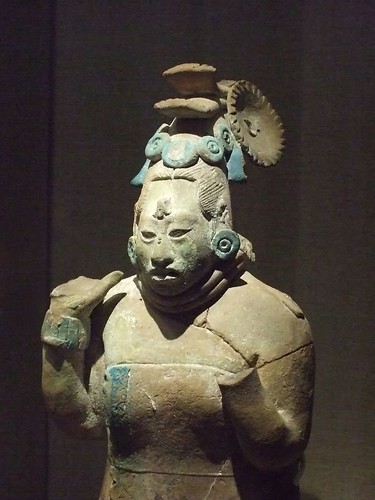The Mayans made the original pigment by burning incense made from tree resin and using the heat to cook a mixture of indigo plants and a type of clay called palygorskite.
"As the mixture was heated, indigo molecules filled a network of tiny channels inside the clay. Some of these bits of indigo plugged the pores on the surface, preventing the color from escaping over time. The clay, in turn, protected the indigo from the environment." - More: FoxNews.com
The research team hopes to use the new synthetic material to restore paintings and is considering other applications such as colored cement.
"Maya blue" first appeared around the 800 A.D. [some researchers claim 300 A.D.] and it was still used in the 16th century in several Convents of Colonial Mexico, notably in the paintings of the Indian Juan Gerson in Tecamachalco. These paintings are a clear example of the combination of Indian and European techniques sometimes known as Arte Indocristiano. After that, the techniques for its production were lost in Mexico but in Cuba there are examples from 1830." - Wikipedia
This painting of the construction of the Tower
of Babel by Juan Gerson created in 1652 was one
of the few colonial period paintings that
incorporated Mayan Blue. (oil on paper)
Research on Maya Blue's composition began as early as the 1950s when chemists used powder diffraction to discover its basic components.
"The actual recipe to reproduce Maya Blue pigment was published in 1993 by a Mexican Historian and Chemist, Constantino Reyes-Valerio. The combination of different of clays: palygorskite, montmorillonite, together with the use of the leaves of the añil and the actual process is described in Reyes-Valerio (1993).[6] Reyes-Valerio's contributions were possible due to his combined background of History and Chemistry, through a thorough revision of primary texts (Sahagun, Hernandez. Jimenez and others), microscopic analysis of the mural paintings and Fourier Transform Infrared Spectroscopy. " - WikipediaThe Maya used the blue pigment for funerary murals and other art objects as well as in their rituals of human sacrifice. In the following scene from Mel Gibson's Apocalypto we see victims coated with blue paint walking past murals depicting human sacrifice on their way to the sacrificial altar.
Of course Mel Gibson's film was panned by historians because it depicted the wholesale slaughter of captives. Some anthropologists [National Geographic video clip] claim that sacrifices were usually restricted to special ceremonies like the induction of a new ruling king or festivals to honor the god of rain intended to bring rain at propitious times to guarantee a bountiful harvest.
Other researchers, including Mari Carmen Serra Puche, have discovered that a number of sacrifices involved women and children [Discovery Magazine video clip]. In either case, it is a far cry from what I was taught as a school girl in the 1950s - that unlike the bloodthirsty Aztecs, the Maya were a peaceful civilization of scholars who studied mathematics and astronomy!
I found a website that said Mayan Blue in digital terms is the color #73C2FB. I don't think using it as a background color for your web page is going to guarantee that it won't fade away (at least in the public consciousness) over time though!!
If you find the Mayan civilization as interesting as I do you may enjoy viewing a slideshow of Mayan art objects I have photographed at the Deyoung Museum of Fine Art in San Francisco, California, the University of Utah Museum of Fine Art in Salt Lake City, Utah, the Field Museum and the Chicago Art Institute in Chicago, Illinois, the Dallas Museum of Fine Arts in Dallas, Texas, the Museum of Man in San Diego, California, and the Metropolitan Museum of Art in New York City.
I have even more images of Mayan art that I will be uploading to Flickr as time permits so you may wish to check back from time to time.






![Apocalypto [Blu-ray]](http://ws.amazon.com/widgets/q?MarketPlace=US&ServiceVersion=20070822&ID=AsinImage&WS=1&Format=_SL160_&ASIN=B000NQQ4ME&tag=romtim-20)



No comments:
Post a Comment